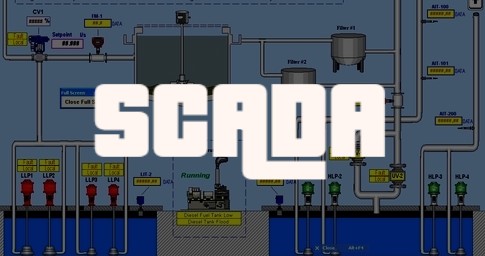SCADA Software consists of several basic modules or components. The most essential module is the I/O module which is meant to communicate with various devices.
The secondary component is Mimic module , followed by Alarm module , Trending and Reporting . Usually a typical SCADA software would need Tag System to share data across all components and get them connected. Lastly the program’s backbone would be powered by a Script/Logic control in order to get them working together in correct sequence and proper order.
On top of basic components, a decent modern SCADA software would further equipped with advanced modules like Redundancy, Scheduler, Recipe, User Management or Internet access with high security implementation.

I/O Driver
I/O driver is meant for SCADA software to communicate with external devices or equipment via its associated communication protocol. This is the most essential feature of a SCADA system. Two of the mostly used communication protocols are Modbus and OPC, due to its legacy and wide support.
The control or changing of equipment parameter will be done through this driver, as well as the status and parameter reading. This reading and writing of data compliment the 4 letters of “Control And Data Acquisition” in SCADA acronym. That’s why this I/O module is the most essential part of SCADA system.
SCADA software mostly connects to the equipment via serial link in RS232/RS485/RS422 before year 2000, but it’s now usually being connected using ordinary computer network either through Ethernet cable or wireless.
Mimic Screen Animation
As the name suggests, Mimic Screen is to imitate the physical look of the devices or equipment on the screen. However, it is meaningless if the mimic just imitate the physical object into the screen. So, the equipment will also reflect the status on the screen itself, and we call this process as animation.
The simplest animation is color changes, representing different status according to specific legend. For instance, Stop status as red, Run status as green. More lively animation would be rotation, or movement for equipment’s state indication. For example a rotating agitator, a level indication, a moving conveyor, etc.
Besides data and status reading, mimic screen also allows user to control the linked up equipment, so that starting or stopping of a system can be done through mouse click. The beauty of Mimic Screen is to allow operators to have the overview of the plant floor without needing them to enter the site to monitor the condition, as well as control the devices without any physical access.
Alarm Annunciation
Alarm annunciation plays a very critical role during operation. It alerts operators to take necessary action for any unwanted event, or when any of the operating parameter is beyond acceptable limit.
A traditional presentation of alarm is through alarm viewer, where alarms will be displayed according to timestamp, sorted under its severity, or any other preferences like grouping. Traditionally, alarm will be logged and printed using dot matrix printer, this is still being practiced in conservative industries and facilities, so that even when power failure or database corrupted, the previously logged alarm can still be traced.
However, modern alarm management would opt to have different path of output. On top of internal database storage, the alarm can also be sent out to individual recipients via email or SMS. This way, the traceability of the alarm or event will still be available in the case of main SCADA system failure.
Historian Trending
Trending is important for analysis and troubleshooting of problem. Some system will split trending into Real-time and Historical, but both serve the same purpose, which is to trend the chosen parameters over time.
Trending allows analytic to be performed on a collection of data, it can be used for preventive maintenance, or to troubleshoot and traced back some occurred incidence.
Report Generation
Reporting is important for production and analytical oriented application. Report generation in SCADA is similar with other application.
Real-time data is stored and tabulated according to required format, some pie/bar charts can be added as needed. And then it can be printed to a printer, or simply generate into PDF as soft copy.